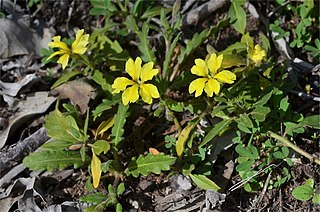Goodenia byrnesii is a species of flowering plant in the family Goodeniaceae and is endemic to northern Australia. It is prostrate to low-lying herb with short-lived, lance-shaped leaves at the base, egg-shaped to oblong, toothed stem leaves, and leafy racemes of yellow flowers.
Goodenia campestris is a species of flowering plant in the family Goodeniaceae and is endemic to northern Australia. It is a low-lying herb with egg-shaped to lance-shaped stem leaves and racemes of yellowish flowers with purple veins.
Goodenia centralis is a species of flowering plant in the family Goodeniaceae and is endemic to central Australia. It is a prostrate, annual herb with coarsely toothed, spatula-shaped to egg-shaped leaves with the narrower end towards the base, and racemes of yellow flowers with purple veins.
Goodenia cirrifica is a species of flowering plant in the family Goodeniaceae and is endemic to northern Australia. It is an ascending, widely branched, sticky herb with short-lived, lance-shaped to egg-shaped leaves at the base, linear stem leaves, and racemes of small yellow flowers.

Goodenia convexa is a species of flowering plant in the family Goodeniaceae and is endemic to Western Australia. It is a low-lying herb with egg-shaped to lance-shaped, usually toothed leaves mostly at the base of the plant, and racemes of yellow flowers.
Goodenia crenata is a species of flowering plant in the family Goodeniaceae and endemic to north-western Australia. It is a perennial, herb with oblong, elliptic or egg-shaped leaves in a rosette at the base of the plant, and leafy racemes of yellow flowers.

Goodenia cycloptera is a species of flowering plant in the family Goodeniaceae and is endemic to Australia. It is a widely distributed, perennial or annual herb with wavy or toothed leaves, yellow flowers arranged in leafy racemes and more or less spherical fruit.
Goodenia cylindrocarpa is a species of flowering plant in the family Goodeniaceae and is endemic to northern Australia. It is an erect annual, herb with spatula-shaped, or lance-shaped to egg-shaped leaves at the base of the plant, and panicles of small yellow flowers.

Goodenia glabra, commonly known as shiny pansy or smooth goodenia, is a species of flowering plant in the family Goodeniaceae and is endemic to drier inland areas of Australia. It is a prostrate to low-lying herb with lobed, oblong to egg-shaped leaves, and racemes of yellow flowers with purplish markings.
Goodenia goodeniacea is a species of flowering plant in the family Goodeniaceae and is endemic to northern, inland Australia. It a prostrate plant with toothed, elliptic to egg-shaped leaves at the base of the plant, and thyrses of yellow flowers with purplish lines.
Goodenia granitica is a species of flowering plant in the family Goodeniaceae and endemic to the south-west of Western Australia. It is an annual herb with spatula-shaped, sometimes lobed leaves, in a rosette at the base of the plant, and racemes of yellow flowers.
Goodenia gypsicola is a species of flowering plant in the family Goodeniaceae and is endemic to areas of salt lakes in inland Australia. It is a perennial herb with spatula-shaped leaves and racemes of pale blue flowers.
Goodenia halophila is a species of flowering plant in the family Goodeniaceae and is endemic to the northern Australia. It is a delicate annual herb with spatula-shaped, or lance-shaped leaves in a tuft at the base of erect or low-lying flowering stems, and cymes of yellow flowers.

Goodenia heterochila, commonly known as serrated goodenia, is a species of flowering plant in the family Goodeniaceae and is endemic to arid areas of Australia. It is an erect or ascending perennial herb with lance-shaped to egg-shaped stem leaves with the narrow end towards the base, and racemes of yellow flowers with a brownish centre.

Goodenia hirsuta is a species of flowering plant in the family Goodeniaceae and is endemic to northern Australia. It is a hairy, prostrate to low-lying perennial herb with narrow egg-shaped leaves at the base of the plant, racemes of hairy yellow flowers and oval to elliptic fruit.
Goodenia hispida is a species of flowering plant in the family Goodeniaceae and is endemic to the Northern Territory. It is a herb with egg-shaped to lance-shaped stem leaves and racemes of yellow flowers.

Goodenia holtzeana is a species of flowering plant in the family Goodeniaceae and is endemic to northern parts of the Northern Territory. It is a prostrate to ascending or erect annual plant with egg-shaped to lance-shaped stem-leaves with the narrower end towards the base, and racemes of yellow flowers with brownish markings.
Goodenia inundata is a species of flowering plant in the family Goodeniaceae and is endemic to the Kimberley region of Western Australia. It is an erect, annual or ephemeral herb with narrow egg-shaped stem-leaves and panicles of purple or maroon flowers with a yellow centre.
Goodenia iyouta is a species of flowering plant in the family Goodeniaceae and is endemic to Western Australia. It is a prostrate herb with toothed, egg-shaped to elliptic stem-leaves, and racemes of dark yellow or cream-coloured flowers with a distinct pouch.
Goodenia kakadu is a species of flowering plant in the family Goodeniaceae and is endemic to the Northern Territory. It is a prostrate herb with narrow oblong leaves in rosettes on stolons, and small, single dark red flowers in leaf axils.





